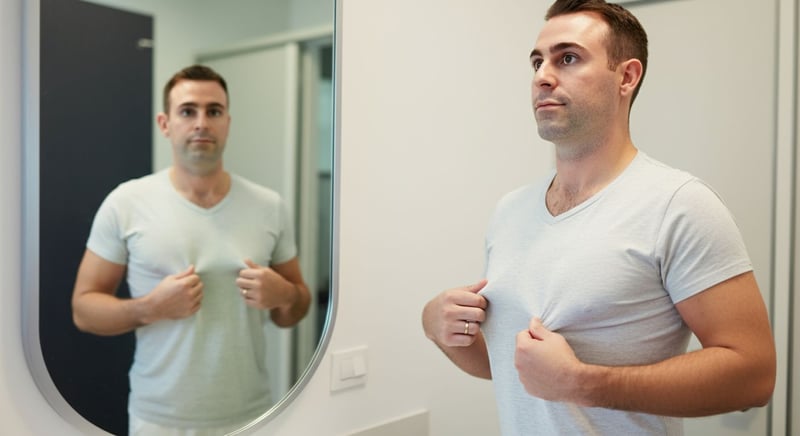Gynecomastia: Unveiling Solutions for Enlarged Male Breasts
Explore effective solutions for gynecomastia available at estethica, where innovation meets patient-centered care.
Gynecomastia, commonly referred to as 'man boobs', is a condition that affects a significant number of men globally. Understanding its causes, available treatments, and recovery options can greatly alleviate the concerns it poses, both physically and emotionally. At estethica, we are committed to providing top-notch care and innovative solutions for aesthetic concerns, including gynecomastia, leveraging our state-of-the-art facilities and expert medical staff.
Understanding Gynecomastia: Causes, Symptoms, and Diagnosis
Deciphering the Primary Causes of Gynecomastia
Gynecomastia arises primarily from a hormonal imbalance, specifically a decrease in testosterone compared to estrogen. This condition can occur during different stages of life, including infancy, puberty, and older adulthood. Newborns might experience temporary gynecomastia due to the transfer of estrogen from the mother. During puberty, hormonal changes are common, which can lead to gynecomastia that usually resolves on its own. However, in older men, it can stem from age-related hormonal shifts or certain medical conditions.
- Hormonal Imbalance: Fluctuations in testosterone and estrogen levels are the primary drivers of gynecomastia, influencing breast tissue development.
- Medications: Certain drugs, such as anti-androgens, anabolic steroids, and antidepressants, can disrupt hormonal balance and induce gynecomastia.
- Medical Conditions: Health issues like hyperthyroidism, kidney failure, and liver cirrhosis can also affect hormone regulation, potentially causing the condition.
Navigating Diagnostic Approaches for Gynecomastia
Diagnosing gynecomastia typically begins with a physical examination to assess breast tissue and identify potential causes. The presence of firm, rubbery tissue around the nipple area is a key indicator. The doctor will also take a detailed medical history to identify any medications, health conditions, or lifestyle factors that might be contributing to the condition. If necessary, further tests, such as blood tests to measure hormone levels or imaging studies like mammograms, may be conducted to rule out other conditions such as breast cancer. Understanding Gynecomastia is important because early diagnosis and treatment is essential for optimal management.
- Physical Examination: This initial step involves manually examining the breast tissue to identify the size, shape, and texture of the affected area.
- Medical History Review: Assessing the patient's past and current health status helps determine potential underlying causes or contributing factors.
- Hormone Level Testing: Blood tests are performed to measure hormone levels, specifically testosterone and estrogen, to identify any imbalances that may be present.

Surgical Male Breast Reduction: Procedures and Expected Outcomes
Surgical Interventions for Addressing Gynecomastia
For those seeking direct intervention, surgical male breast reduction involves the removal of excess breast fat or glandular tissue, resulting in a flatter, firmer chest contour. The procedures typically involve liposuction and excision techniques, tailored to the patient's needs. At estethica, surgeries are performed by seasoned professionals using cutting-edge technologies to ensure minimal scarring and rapid recovery times, reflecting our commitment to patient care and safety. Surgical options like male breast reduction are frequently sought by those looking to correct the appearance of enlarged male breasts, offering a more contoured chest.
- Liposuction: Effective for removing excess fat, particularly when gynecomastia is primarily caused by fatty tissue rather than glandular proliferation.
- Excision: Involves the surgical removal of glandular tissue and excess skin, often necessary when the condition involves significant glandular enlargement or skin laxity.
- Combination Techniques: Tailoring the approach by combining liposuction and excision provide optimal results, addressing both fat and glandular components for enhanced chest contouring.
Understanding What to Expect and Considering the Cost of Gynecomastia Surgery
Patients considering surgical interventions for gynecomastia often have questions about potential discomfort and the duration of the procedure. Surgical approaches at estethica aim to minimize discomfort with advanced anesthesia and surgical techniques. Typically, the procedures are completed within a few hours, depending on the extent of correction needed. Post-operative care is crucial for a smooth recovery. estethica provides comprehensive support, including detailed aftercare instructions and follow-up appointments. Potential patients also explore gynecomastia surgery in order to decide what suits them best.
- Initial Consultation: The process begins with a thorough evaluation and discussion of goals to determine the most appropriate surgical technique.
- Surgical Procedure: Utilizing either liposuction, excision, or a combination, our skilled surgeons carefully reshape the chest to create a more masculine contour.
- Post-Operative Care: Comprehensive aftercare including pain management, wound care, and follow-up visits ensures optimal healing and patient satisfaction.

Non-Surgical Gynecomastia Treatments: Exploring Alternative Options
Exploring Lifestyle Adjustments and Medical Interventions
For individuals exploring alternatives to surgery, several non-surgical treatments can effectively manage gynecomastia. Lifestyle adjustments, such as committing to a balanced diet and engaging in regular, targeted exercises, play a crucial role in reducing chest fat and improving overall body composition. In some cases, hormonal imbalances contribute to gynecomastia. Addressing these imbalances with prescribed medication can alleviate symptoms.
- Balanced Diet: A diet rich in lean proteins, whole grains, and adequate fruits and vegetables can help reduce overall body fat, including chest fat.
- Targeted Exercises: Exercises such as chest presses, push-ups, and dumbbell flyes can help strengthen pectoral muscles, improving chest appearance.
- Medications: Certain medications can rebalance hormone levels, addressing the underlying cause of gynecomastia, especially during hormonal fluctuations.
Innovative Non-Invasive Methods at estethica
estethica offers cutting-edge, non-invasive treatments designed to effectively combat gynecomastia symptoms with minimal discomfort and downtime. These therapies use advanced technologies to target and reduce excess fat and glandular tissue. We understand that each patient has unique needs; therefore, our experts tailor treatment plans to suit individual conditions, ensuring personalized care and optimal outcomes. With a focus on patient comfort and satisfaction, estethica remains committed to delivering the highest standards of non-surgical gynecomastia care.
- Personalized Consultation: A thorough assessment to understand the patient's specific condition and aesthetic goals to determine the most appropriate non-surgical approach.
- Customized Treatment Plan: Tailoring a combination of non-invasive methods to address the specific type and severity of gynecomastia, focusing on individual needs.
- Follow-Up and Support: Providing continuous support and monitoring to ensure the effectiveness of the treatment and patient satisfaction with the results.

Gynecomastia Surgery Recovery: Tips for a Smooth Healing Process
Essential Components of Post-Operative Gynecomastia Care
Post-surgery care is paramount for ensuring a successful and swift recovery following gynecomastia surgery. Patients are strongly advised to meticulously adhere to a prescribed care regimen that includes consistently wearing compression garments, diligently following activity restrictions, and regularly attending all scheduled follow-up appointments. At estethica, we are dedicated to providing comprehensive post-operative support. We focus on facilitating a smooth and comfortable recovery for our patients, which helps in achieving optimal and desired results. Our holistic approach ensures each patient receives personalized attention and support throughout their recovery, enhancing satisfaction.
- Compression Garments: Wearing prescribed compression garments helps reduce swelling, supports the healing tissue, and aids in contouring the chest area post-surgery.
- Activity Restrictions: It is essential to avoid strenuous activities and heavy lifting during the initial recovery phase to prevent complications and promote proper healing.
- Follow-Up Appointments: Regular check-ups with your surgeon help monitor progress, address concerns, and ensure the healing process is on track for the best possible outcome.
Navigating the Recovery Timeline After Gynecomastia Surgery
Understanding the recovery timeline is essential for patients undergoing gynecomastia surgery. Initially, expect some swelling and discomfort which can be managed with prescribed medication. During the first few weeks, limiting physical activity is crucial to allow the body to heal properly. estethica’s approach involves detailed aftercare guidance and support. We ensure that patients understand each phase of their recovery. Gradual return to normal activities is advised, and full recovery, along with the final aesthetic results, becomes evident over several months as swelling subsides and tissues settle. We also consider treatment of gynecomastia and provide personalized guidance.
- Immediate Post-Op: Focus on rest, managing discomfort with prescribed medication, and adhering to all garment instructions.
- Weeks 1-4: Continue wearing compression garments, gradually increase light activities, and avoid heavy lifting to support optimal healing.
- Months 2-6: As swelling gradually subsides, resume normal activities, and observe the final aesthetic outcomes take shape as the chest contours refine.
Advanced Liposuction and Excision Techniques for Optimal Gynecomastia Correction
Personalized Gynecomastia Treatment Plans for Enhanced Patient Satisfaction
Frequently Asked Questions
What is gynecomastia and what are the primary causes of 'man boobs'?
What are the surgical options available for male breast reduction?
Are there non-surgical gynecomastia options to treat enlarged male breasts?
What does the recovery process involve after gynecomastia surgery?
How common is gynecomastia, and what factors contribute to its development?
Ready to discover the perfect aesthetic solution for your unique needs with estethica's expert guidance?
📞 Get Your Free Consultation!